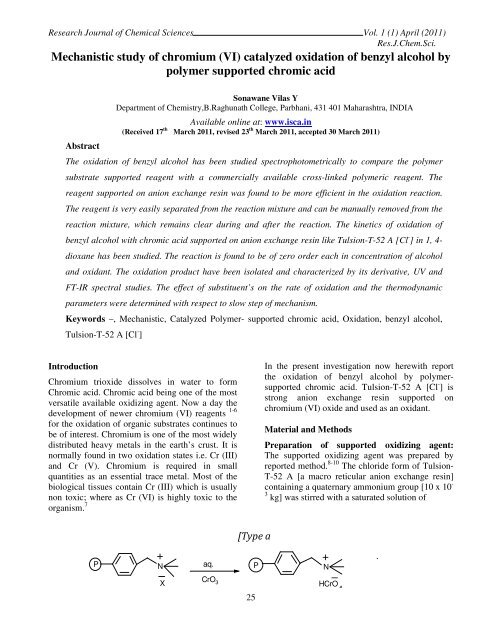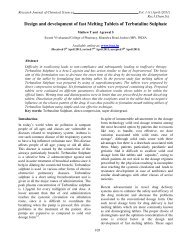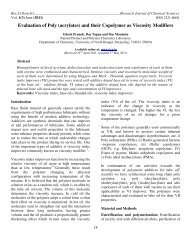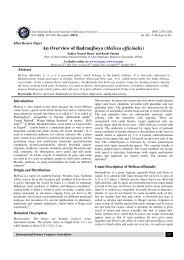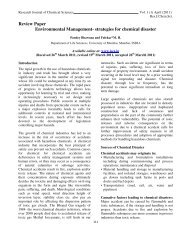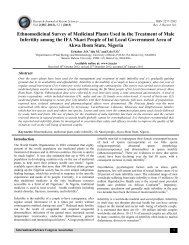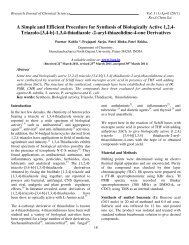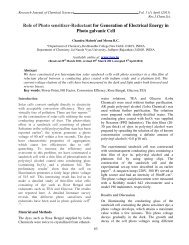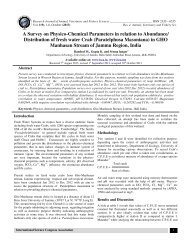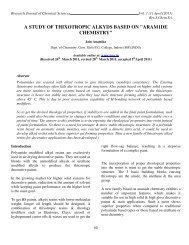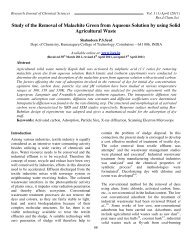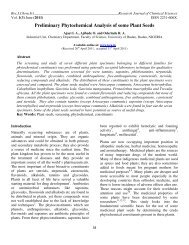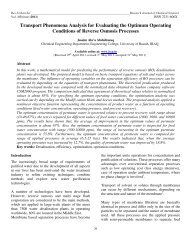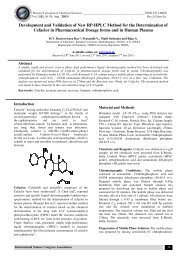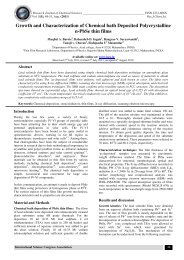Mechanistic study of chromium (VI) catalyzed oxidation of ... - ISCA
Mechanistic study of chromium (VI) catalyzed oxidation of ... - ISCA
Mechanistic study of chromium (VI) catalyzed oxidation of ... - ISCA
Create successful ePaper yourself
Turn your PDF publications into a flip-book with our unique Google optimized e-Paper software.
Research Journal <strong>of</strong> Chemical Sciences Vol. 1 (1) April (2011)<br />
Res.J.Chem.Sci.<br />
<strong>Mechanistic</strong> <strong>study</strong> <strong>of</strong> <strong>chromium</strong> (<strong>VI</strong>) <strong>catalyzed</strong> <strong>oxidation</strong> <strong>of</strong> benzyl alcohol by<br />
polymer supported chromic acid<br />
Abstract<br />
Sonawane Vilas Y<br />
Department <strong>of</strong> Chemistry,B.Raghunath College, Parbhani, 431 401 Maharashtra, INDIA<br />
Available online at: www.isca.in<br />
(Received 17 th March 2011, revised 23 th March 2011, accepted 30 March 2011)<br />
The <strong>oxidation</strong> <strong>of</strong> benzyl alcohol has been studied spectrophotometrically to compare the polymer<br />
substrate supported reagent with a commercially available cross-linked polymeric reagent. The<br />
reagent supported on anion exchange resin was found to be more efficient in the <strong>oxidation</strong> reaction.<br />
The reagent is very easily separated from the reaction mixture and can be manually removed from the<br />
reaction mixture, which remains clear during and after the reaction. The kinetics <strong>of</strong> <strong>oxidation</strong> <strong>of</strong><br />
benzyl alcohol with chromic acid supported on anion exchange resin like Tulsion-T-52 A [Cl - ] in 1, 4-<br />
dioxane has been studied. The reaction is found to be <strong>of</strong> zero order each in concentration <strong>of</strong> alcohol<br />
and oxidant. The <strong>oxidation</strong> product have been isolated and characterized by its derivative, UV and<br />
FT-IR spectral studies. The effect <strong>of</strong> substituent’s on the rate <strong>of</strong> <strong>oxidation</strong> and the thermodynamic<br />
parameters were determined with respect to slow step <strong>of</strong> mechanism.<br />
Keywords –, <strong>Mechanistic</strong>, Catalyzed Polymer- supported chromic acid, Oxidation, benzyl alcohol,<br />
Tulsion-T-52 A [Cl - ]<br />
Introduction<br />
Chromium trioxide dissolves in water to form<br />
Chromic acid. Chromic acid being one <strong>of</strong> the most<br />
versatile available oxidizing agent. Now a day the<br />
development <strong>of</strong> newer <strong>chromium</strong> (<strong>VI</strong>) reagents 1-6<br />
for the <strong>oxidation</strong> <strong>of</strong> organic substrates continues to<br />
be <strong>of</strong> interest. Chromium is one <strong>of</strong> the most widely<br />
distributed heavy metals in the earth’s crust. It is<br />
normally found in two <strong>oxidation</strong> states i.e. Cr (III)<br />
and Cr (V). Chromium is required in small<br />
quantities as an essential trace metal. Most <strong>of</strong> the<br />
biological tissues contain Cr (III) which is usually<br />
non toxic; where as Cr (<strong>VI</strong>) is highly toxic to the<br />
organism. 7<br />
In the present investigation now herewith report<br />
the <strong>oxidation</strong> <strong>of</strong> benzyl alcohol by polymersupported<br />
chromic acid. Tulsion-T-52 A [Cl - ] is<br />
strong anion exchange resin supported on<br />
<strong>chromium</strong> (<strong>VI</strong>) oxide and used as an oxidant.<br />
Material and Methods<br />
Preparation <strong>of</strong> supported oxidizing agent:<br />
The supported oxidizing agent was prepared by<br />
reported method. 8-10 The chloride form <strong>of</strong> Tulsion-<br />
T-52 A [a macro reticular anion exchange resin]<br />
containing a quaternary ammonium group [10 x 10 -<br />
3 kg] was stirred with a saturated solution <strong>of</strong><br />
[Type a<br />
P<br />
+<br />
N<br />
aq.<br />
P<br />
+<br />
N<br />
X<br />
CrO 3<br />
25<br />
HCrO 4
Research Journal <strong>of</strong> Chemical Sciences Vol. 1 (1) April (2011)<br />
Res.J.Chem.Sci.<br />
Chromium trioxide [5 x 10 -3 dm 3 ] in water [30 x10 -<br />
3 dm 3 ] for 30 minutes at room temperature using a<br />
magnetic stirrer. The chloride ion was readily<br />
-<br />
displaced and HCrO 4 form <strong>of</strong> resin was obtained in<br />
30 min. The resin was successively rinsed with<br />
water, acetone and THF and finally dried in<br />
vaccum at 323 K for 5h. The dried form <strong>of</strong> the<br />
resin was stored and used throughout the kinetic<br />
<strong>study</strong>.<br />
Determination <strong>of</strong> the capacity <strong>of</strong> chromate form<br />
<strong>of</strong> the polymeric reagent: The capacity <strong>of</strong> the<br />
chromate form <strong>of</strong> Tulsion-T-52 A [Cl - ] polymeric<br />
reagent was determined by iodometrically. The<br />
capacity <strong>of</strong> the chromate form <strong>of</strong> resin was 6.90<br />
mmol/g and used for kinetic <strong>study</strong> throughout<br />
work. The loading was also determined by<br />
elemental nitrogen analysis and was found to be<br />
6.82 mmol/g.<br />
Chemicals and Reagents: All reagents used were<br />
<strong>of</strong> Analytical Grade and all solutions were<br />
prepared with double distilled water.<br />
Kinetics <strong>of</strong> <strong>oxidation</strong>: The reaction mixture for<br />
the kinetic run was prepared by mixing benzyl<br />
alcohol, oxidant and solvent. The reaction was<br />
carried out either constant stirring using magnetic<br />
stirrer and at a constant temperature 318 ±1 K. At<br />
different time interval, the reaction mixture was<br />
withdrawn using a micropipette. The aliquot thus<br />
withdrawn was taken in a stoppered test tube<br />
containing 5 x 10 -3 dm 3 <strong>of</strong> 1, 4-dioxane and<br />
subjected to spectral analysis. The absorbance <strong>of</strong><br />
the product formed was measured using SL 159<br />
UV-visible spectrophotometer. Duplicate kinetic<br />
runs showed that the rate constants were<br />
reproducible to within ±3 %.<br />
Induced polymerization test: Mixing <strong>of</strong> oxidant,<br />
benzyl alcohol and solvent at 318 K with<br />
continuous stirring initiation <strong>of</strong> reaction. After 30<br />
min, the reaction mixture was withdrawn in a test<br />
tube and acrylonitrile was added. The mixture after<br />
dilution with distilled water formed a copious<br />
precipitate. The precipitate formed, due to<br />
polymerization <strong>of</strong> acrylonitrile, indicates formation<br />
<strong>of</strong> a free radical species in the reaction 11 . It was<br />
also confirmed by ESR spectral analysis as well as<br />
on diluting the reaction mixture with acidified<br />
methanol, a precipitate formed, suggested the<br />
2<br />
26<br />
possibility <strong>of</strong> free radical interventation in the<br />
reaction.<br />
Product analysis: The <strong>oxidation</strong> <strong>of</strong> benzyl alcohol<br />
leads to the formation <strong>of</strong> benzaldehyde. The<br />
product formed was analyzed by their 2, 4-<br />
dinitrophenylhydrazine derivatives. The<br />
precipitated 2, 4-DNP was filtered <strong>of</strong>f, the product<br />
is then vacuum dried, weighed and recrystallised<br />
from ethanol. The yield <strong>of</strong> 2, 4-DNP<br />
recrystallisation with the DNP <strong>of</strong> benzaldehyde<br />
was 99%. The product benzaldehyde also<br />
identified either by comparison with authentic<br />
sample or by UV, FT-IR spectral and elemental<br />
analysis. The IR spectra was recorded on a Jasco<br />
FT-IR spectrophotometer using KBr pellets. The<br />
melting point <strong>of</strong> 2,4-DNP derivative <strong>of</strong><br />
benzaldehyde is 509K.<br />
UV Spectrum λmax 247 nm.<br />
IR data: - A sharp band at 1690 cm -1 for -CHO<br />
stretching mode, 1582 cm -1 aromatic (- C = C-),<br />
3060 cm -1 (-C- H stretch).<br />
Result and Discussion<br />
Effect <strong>of</strong> oxidant: The order with respect to<br />
weights oxidant is zero, as the plots <strong>of</strong> absorbance<br />
against time were linear in all runs and observed<br />
rate constant are fairly constant between 120 to 180<br />
x 10 -6 kg <strong>of</strong> oxidant at constant concentration <strong>of</strong><br />
solvent (1, 4- dioxane, 10 x 10 -3 dm 3 ) and benzyl<br />
alcohol (15 x 10 -3 mol/dm -3 ), the effect <strong>of</strong> varying<br />
weights <strong>of</strong> oxidant on zero order rate constant as<br />
shown in Table-1.<br />
Effect <strong>of</strong> concentrations <strong>of</strong> benzyl alcohol:<br />
At a varying concentration <strong>of</strong> benzyl alcohol [10<br />
to 25 x 10 -3 mol/dm 3 ], constant weights <strong>of</strong> oxidant<br />
[140 x 10 -6 kg] and constant concentration <strong>of</strong><br />
solvent [1,4-dioxane, 10 x 10 -3 dm 3 ], zero order rate<br />
constant [Table- 2] was found.<br />
Effect <strong>of</strong> dielectric permittivity: It was found that<br />
as the dielectric constant <strong>of</strong> the medium increased,<br />
this including r* < r [Where r* and r refer to the<br />
radii <strong>of</strong> the reactant species and activated complex<br />
respectively] at constant concentration <strong>of</strong> benzyl<br />
alcohol [15 x 10 -3 mol/dm 3 ] and constant<br />
concentration <strong>of</strong> oxidant [140 x 10 - 6 Kg], solvent<br />
[10x 10 -3 dm 3 ] as shown in Table-3.
Research Journal <strong>of</strong> Chemical Sciences Vol. 1 (1) April (2011)<br />
Res.J.Chem.Sci.<br />
Effect <strong>of</strong> temperature: The reaction was carried Scheme (III)<br />
out at four different temperatures to <strong>study</strong> the 2Cr V → Cr III + Cr V (3)<br />
effect <strong>of</strong> temperatures on the rate <strong>of</strong> reaction. It Cr V +Red → Cr III + oxi (4)<br />
was observed that, the rate <strong>of</strong> reaction increased<br />
with an increase in the temperature. [Table-4]. The Westheimer then proposed that the <strong>oxidation</strong> <strong>of</strong><br />
thermodynamic parameters like energy <strong>of</strong> primary alcohols proceeded via acid<br />
activation [Ea], enthalpy <strong>of</strong> activation [∆H # ], chromate ester intermediates.<br />
entropy <strong>of</strong> activation [∆S # ] free energy <strong>of</strong> R 2 CHOH + HCrO 4 + H + →R 2 CHOCrO 3 H + H 2 O<br />
activation [∆G # ] and frequency factor [A] were (5)<br />
calculated by determining values <strong>of</strong> k at different<br />
+<br />
R 2 CHOCrO 3 H + H+ →R 2 CHOCrO 3 H 2 (6)<br />
temperatures. [Table-5].<br />
Discussion<br />
Several sets <strong>of</strong> experiments with various weights <strong>of</strong><br />
oxidant, concentration <strong>of</strong> benzyl alcohol and<br />
change in solvent were carried out. The reaction<br />
was found to be zero order. The proposed path for<br />
the reaction <strong>of</strong> <strong>chromium</strong> (IV) then makes possible<br />
a different mechanism for <strong>oxidation</strong> <strong>of</strong> benzyl<br />
alcohol. According to Westheimer and Watanable<br />
[12], subsequent steps must involve <strong>chromium</strong> (IV)<br />
as shown in Scheme (II) and (III).<br />
Scheme (II)<br />
Cr IV + Cr <strong>VI</strong> →2Cr V (1)<br />
Cr V + R 2 CHOH → R 2 C = O + Cr III + 2H + (2)<br />
If the oxidant supported on polymer, which has<br />
certain advantages over homogeneous reaction, the<br />
intermediate <strong>chromium</strong> (IV) will further oxidize<br />
another molecule <strong>of</strong> benzyl alcohol to form a free<br />
radical species. Thus based on experimental<br />
results, obtained for the <strong>oxidation</strong> <strong>of</strong> benzyl alcohol<br />
by polymer support, the reaction was found to be<br />
0 th order. Initially Cr (<strong>VI</strong>) is reduced to Cr (IV). It<br />
is likely to react with another Cr (<strong>VI</strong>) to generate<br />
Cr (V) which is then reduced in a fast step to the<br />
ultimate product Cr (III). Such a sequence <strong>of</strong><br />
reactions in Cr (<strong>VI</strong>) <strong>oxidation</strong> is well known. 13-15<br />
The mechanism is suggested in Scheme (IV) and<br />
involves ester formation.<br />
The polymer supported reagent reacts with a<br />
molecule <strong>of</strong> benzyl alcohol to form a chromate<br />
ester.<br />
Table-1: Effect <strong>of</strong> oxidant on reaction rate<br />
Oxidant x 10 - 6 kg 120 140 160 180<br />
k x 10 - 4 min -1 2.10 2.15 2.25 2.30<br />
Table-2: Effect <strong>of</strong> concentrations <strong>of</strong> benzyl alcohol on the reaction rate<br />
Benzyl alcohol 10 x 10 -3<br />
mol /dm 3 15x 10 -3<br />
mol /dm 3 20 x 10 -3<br />
25 x 10 -3<br />
mol /dm 3 mol /dm 3<br />
k x 10 - 4 min -1 3.20 4.10 4.50 5.10<br />
Table-3: Effect <strong>of</strong> dielectric permittivity <strong>of</strong> the medium on the reaction rate<br />
Temperature K → 313 318 323 328<br />
k x 10 - 4 min -1 3.20 4.30 4.90 6.20<br />
27 3
Table - 4. Effect <strong>of</strong> temperature on the reaction rate<br />
Temperature K → 313 318 323 328<br />
k x 10 - 4 min -1 3.20 4.30 4.90 6.20<br />
Table -5. Thermodynamic parameters for the <strong>oxidation</strong> <strong>of</strong> benzyl alcohol<br />
Energy <strong>of</strong> activation [Ea] KJ mol -1 84 ± 4<br />
Enthalpy <strong>of</strong> activation [∆H # ] KJ mol -1 49 ± 3<br />
Entropy <strong>of</strong> activation [∆S # ] JK mol -1 -55 ± 2<br />
Free energy <strong>of</strong> activation [∆G # ] KJ mol -1 256 ± 2<br />
Frequency factor [A] X 10 -5 s -1 3 ± 0.5<br />
P<br />
+ -<br />
N(CH 3<br />
) 3<br />
HCrO 4<br />
+<br />
RCH 2<br />
OH<br />
O<br />
+ -<br />
P N(CH 3<br />
)O Cr<br />
3<br />
OH 2<br />
C R + H O 2<br />
O<br />
The ester formed will decompose into aldehyde and the intermediate <strong>chromium</strong> (IV) will be formed in the second<br />
and slow step.<br />
O<br />
P<br />
+ -<br />
N ( C H 3<br />
) O<br />
3<br />
C r<br />
O H 2<br />
C<br />
R<br />
O<br />
k , S lo w<br />
+<br />
IV<br />
P N ( C H 3<br />
) 3<br />
( C r )<br />
+<br />
R C H O H<br />
+ +<br />
28
Research Journal <strong>of</strong> Chemical Sciences Vol. 1 (1) April (2011)<br />
Res.J.Chem.Sci.<br />
The intermediate <strong>chromium</strong> (IV) thus reacts with another benzyl alcohol molecule to produce a free radical<br />
species.<br />
+<br />
P N ( CH3<br />
) C 3 r IV<br />
+ RCH 2<br />
OH<br />
FAST<br />
+<br />
P N ( CH3<br />
) C III 3 r + RCHOH+ H<br />
+<br />
Subsequently the free radical reacts with another oxidant site in the polymeric reagent in a fast step leading to the<br />
formation <strong>of</strong> <strong>chromium</strong> (V).<br />
+ -<br />
P N(CH 3<br />
) 3<br />
HCrO 4 + .<br />
RCHOH<br />
FAST<br />
+<br />
V<br />
P N(CH 3<br />
) 3<br />
(Cr) H + RCHO<br />
+ +<br />
The intermediate <strong>chromium</strong> (V) in the last step reacts with benzyl alcohol produce benzaldehyde.<br />
Acknowledgements<br />
I wish to express my deep sense <strong>of</strong> gratitude to<br />
Hon’ble Adv.Ashok Soni, President, Godavari<br />
Shikshan Prasarak Mandal’s, B. Raghunath Arts,<br />
Science and Commerce,College Parbhani and Pr<strong>of</strong>.<br />
Smt. Nandini P. Hilage, Department <strong>of</strong> Chemistry,<br />
Shivaji University, Kolhapur.<br />
29 5<br />
Conclusion<br />
According to Scheme IV, a second order rate law is<br />
expected. But since the first step <strong>of</strong> ester formation<br />
occurs in solid phase and assuming that this<br />
equilibrium does not contribute to the rate <strong>of</strong><br />
reaction. We obtained zero order dependence with<br />
rate constant k <strong>of</strong> the second slow step in which<br />
product benzaldehyde was obtained. Based on the<br />
experimental observations a probable mechanism is<br />
suggested.
Research Journal <strong>of</strong> Chemical Sciences Vol. 1 (1) April (2011)<br />
Res.J.Chem.Sci.<br />
References<br />
8a. Kakde S.A. and Hilage N.P., Trans. Metal<br />
Chem., 32, 940-943 (2007)<br />
1. Corey E. J. and Schmidt G., Tetrahedron Lett.,<br />
20, 399 (1979)<br />
2. Bhattacharjee M. N. Choudhari M. K. Dasgupta<br />
H. S., Roy N. and Khating D. T., Synthesis., 58<br />
(1982)<br />
3. Corey E. J. Barette E.P.M. and Margrious P.A.,<br />
Tetrahedron Lett., 24, 5855 (1985)<br />
4. Climinale F., Camporeale M., Mello R., Troisi L.<br />
and Curci R., Chem. Soc.,Perkon Trans., 2, 417<br />
(1989)<br />
5. Sharma G. G. and Mahanti M. K. Bull., Soc<br />
Chem. Fr., 128, 449 (1991)<br />
6. Balasubramanian K. and Pratibha V., Indian J.<br />
Chem., Sec. B., 25, 326 (1986)<br />
7. Narayana B. and Tam Cherian, J. Braz. Chem.<br />
Soc., 16, 197 (2005)<br />
8. Jawanjal A. L. and Hilage N. P., Indian J.Chem.,<br />
44A, 1827 (2005)<br />
9. Cainelli G., Cardillio G., Orena M. and Sardri S.,<br />
J. Am. Chem. Soc., 98, 6767 (1976)<br />
10. Brunlet T., Jouitteau C. and Gelhard G., J. Org.<br />
Chem., 51 , 4016 (1986 )<br />
11. Mosher W. A., Clement H. and Hillard R. L., J.<br />
Am .Chem. Soci., 29, 565 (1993)<br />
12. Watanabe W. and Westheimer F. H., J. Chem.<br />
Phys., 61, 17 (1979)<br />
13. Salunke M. M., Salunke D. G., Kanade A. S.,<br />
Mane R. B. and Wadgaonkar P. P., Synth<br />
Commun.,2B, 1143 (1990)<br />
14. Matsuo J., Kawana A., Pudhon K., and<br />
Mukaiyama T., Chem. Lett., 250 (2002)<br />
15. Hutchins R. O., Natale N. R., and Cook W. J.,<br />
Tetrahedron Lett., 4167 (1977)<br />
30 6


